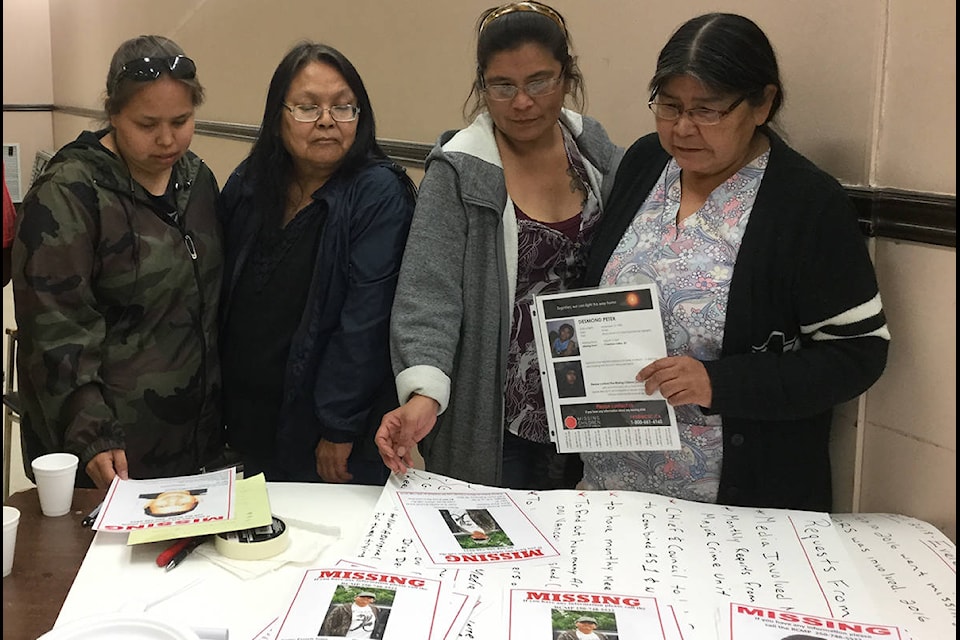Patsy Jones has spent several months organizing the second annual Walk for Missing and Murdered Men, Women and Children.
It’s a huge task, with a long list of details to attend to, hoops to negotiate and volunteers to recruit. For Jones, it’s important work and it’s personal.
“My sister, Cathy Joe, was murdered in 1977,” explains Jones, who says the brutal death of her eldest sibling was devastating for her family. “It’s one of the big reasons I’m doing this.
“She was beaten, raped and her body was found in a ditch beside Vimy Road by a hiker.”
Jones, the youngest of six children born to Evelyne and Benedict Joe, was just a child at the time of Cathy’s murder but she knows the details of what has turned into a longstanding cold case with few clues.
“The RCMP came to our home and said Cathy was deceased. They took only my mother to see her. We tried to tell them she shouldn’t go alone, she wasn’t healthy, but they didn’t care,” Jones says.
The loss of 27-year-old Cathy took a painful toll on her mother.
“She died of a broken heart,” Jones believes.
Over the years, Jones says, investigators have had little contact with the family and even a CrimeStoppers plea failed to produce any leads. There are rumours but no one has ever come forward with information that would lead police to the person who killed Cathy.
Sadly, other families in the Cowichan region have experienced the heartbreak of losing a loved one over the years. In some cases, Aboriginal men and women have been murdered and their bodies recovered. In other cases, people have vanished and their families are desperate for answers.
No one has a definitive number of missing and murdered men and women cases over the years but some of the recent ones include:
• Desmond Peter, a 14-year-old who went missing in 2007. He was last seen near the old Malaspina College on Cowichan Way near the Trans-Canada Highway.
• Tyeshia Jones, 18, was murdered by William Elliott on Jan. 22, 2011. Her body was found after six days in the woods behind the Shaker Church on Cowichan Tribes land.
• Delores (Deedee) Brown, a 19-year-old woman from Penelakut, was reported missing in late July of 2015. Her body was discovered three weeks later on a Norway Island beach. Police continue to investigate her murder.
• Ian Henry, was last seen in August of 2015. He was 26 when he disappeared.
• Everett Jones, 47, was last seen leaving his home in the Club Road area in Duncan on the morning of Feb. 10, 2016.
For Patsy Jones, the 2nd Annual Walk for Missing and Murdered Men, Women and Children that will take place on Saturday, Feb. 9 helps to keep the memory of her sister alive and hopefully the march will help uncover some clues into deaths and missing persons cases.
“They found her but didn’t find who took her. I’m hoping someone will come forward with information.”
Saturday’s walk will take participants through the streets of Duncan. Last year’s march drew more than 1,000 supporters and Jones expects the number to be even larger this year.
Leaders from First Nations communities on the Island have been invited as have political leaders including MP Alistair MacGregor, MLAs Sonia Furstenau and Doug Routley and municipal officials.
“This march is being sponsored by Halalt Tribe and I thank Chief Bert Thomas for his 100 per cent support,” Jones says.
“It has been a lot of work to bring leadership together under one roof, but it’s been great.”
Jones says businesses like Tim Hortons, who will be supplying coffee and Timbits for the marchers, and Chances casino have also stepped up to help.
Tsow-Tun-Le Lum, an organization that delivers culturally based mental health and addictions services will be participating in the march.
Registration begins at 9 a.m. at Quwustun Cultural Centre with an opening prayer and the start of the walk at 11 a.m.
Jones says she is hoping not only First Nations people but the broader community will learn more about the issue of missing and murdered Indigenous people, suggesting the true numbers are larger than people realize.
“There’s lots,” she says solemnly.
